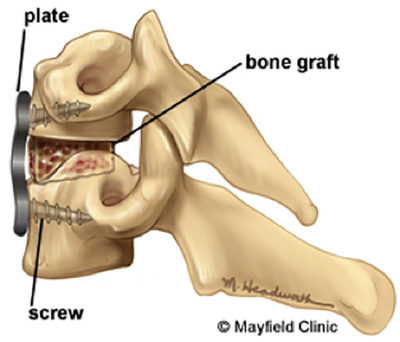Anterior Cervical Fusion: Restoring Stability and Relieving Pain in the Neck
Neck pain-seriously debilitating condition-alters life and lifestyle. After sufficient conservative treatments, such as physiotherapy or medications, anterior cervical fusion surgery...

Neck pain-seriously debilitating condition-alters life and lifestyle. After sufficient conservative treatments, such as physiotherapy or medications, anterior cervical fusion surgery becomes an option that holds promise. This procedure can ease pain, restore stability, or improve neurologic function in the cervical spine (the neck region). This article attempts to talk about anterior cervical fusion surgery in the terms of conditions it addresses, the method, recovery, and possible risks.
Understanding the Need for Anterior Cervical Fusion
The cervical spine is a complex structure composed of seven vertebrae, separated by intervertebral discs that act as shock absorbers. Over time, these discs can degenerate due to aging, injury, or other factors. This degeneration can lead to a variety of problems, including:
- Herniated Disc: The soft inner core of the disc can protrude through a tear in the outer layer, compressing nearby nerves.
- Spinal Stenosis: The spinal canal, which houses the spinal cord, narrows, putting pressure on the cord and nerves.
- Spondylosis: Age-related wear and tear on the spinal bones and discs, leading to stiffness and pain.
- Cervical Instability: Weakening of the ligaments and muscles that support the spine, causing excessive movement and pain.
These conditions can cause a range of symptoms, including neck pain, stiffness, headaches, numbness, tingling, and weakness in the arms and hands. In severe cases, spinal cord compression can lead to difficulty with walking and bladder control.
What is Anterior Cervical Fusion Surgery?
Anterior cervical fusion (ACF) surgery is a surgical procedure performed from the front (anterior) of the neck to stabilize the cervical spine. The goal is to eliminate movement between two or more vertebrae, effectively fusing them together into a single, solid bone. This process alleviates pain and pressure on the nerves and spinal cord, restoring stability and improving neurological function.
The typical steps involved in anterior cervical fusion surgery are:
- Incision: A small incision is made in the front of the neck, usually along a skin crease to minimize scarring.
- Muscle Retraction: The muscles in the neck are carefully retracted to expose the cervical spine. Critical structures like the esophagus and trachea are gently moved aside.
- Disc Removal: The damaged or degenerated intervertebral disc is carefully removed.
- Bone Graft Placement: A bone graft, which can be either autograft (taken from the patient’s own body, often the hip), allograft (from a deceased donor), or synthetic bone graft substitute, is inserted into the space where the disc was removed. This graft acts as a scaffold for new bone to grow.
- Stabilization: A plate and screws are typically used to further stabilize the vertebrae and promote fusion. This hardware helps to hold the bones in place while the bone graft heals and fuses the vertebrae together.
- Closure: The muscles are repositioned, and the incision is closed with sutures.
The Recovery Process
The recovery period following anterior cervical fusion surgery is crucial for successful healing and long-term results. In the immediate postoperative period, patients can expect some discomfort and swelling in the neck. Pain medication is typically prescribed to manage pain. A cervical collar is often worn for several weeks to provide support and limit movement while the fusion heals.
Physical therapy plays a vital role in the recovery process, helping patients regain strength, flexibility, and range of motion in the neck. The therapist will guide patients through exercises designed to improve posture, reduce pain, and restore functional abilities.
The time it takes for the fusion to heal completely varies from person to person, but it typically takes several months. During this time, patients are advised to avoid activities that could put stress on the neck, such as heavy lifting and strenuous exercise. Regular follow-up appointments with the surgeon are necessary to monitor the healing process and address any concerns.
Potential Risks and Complications
As with any surgical procedure, anterior cervical fusion surgery carries some potential risks and complications, including:
- Infection: Though rare, infection can occur at the surgical site.
- Bleeding: Excessive bleeding can occur during or after surgery.
- Nerve Damage: There is a risk of injury to the recurrent laryngeal nerve, which can cause hoarseness or difficulty swallowing. Injury to other nerves in the neck can also occur, leading to numbness, tingling, or weakness.
- Graft Failure: The bone graft may not fuse properly, requiring further surgery.
- Hardware Failure: The plate and screws can break or become loose.
- Adjacent Segment Disease: Fusion can place increased stress on the adjacent vertebrae, potentially leading to degeneration and pain in the future.
Conclusion
Anterior cervical fusion surgery can be a highly effective treatment option for individuals suffering from debilitating neck pain caused by various cervical spine conditions. By stabilizing the spine, relieving pressure on the nerves and spinal cord, and restoring function, this procedure can significantly improve quality of life. While it is essential to understand the potential risks and complications, consulting with a qualified spine surgeon can help determine if anterior cervical fusion surgery is the right choice for your specific condition and needs. A comprehensive evaluation and open communication are key to making an informed decision and achieving the best possible outcome.

